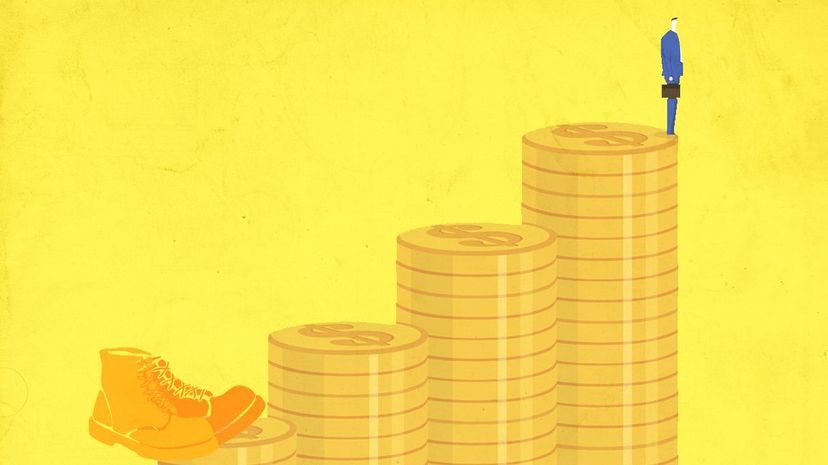
Imagine there are two children: one who is born poor but works hard, and one who is born wealthy but is lazy. Which of them will be more economically successful?
If you're like the majority of Americans who answered this question for a Pew Charitable Trusts survey in 2011, then you picked the hardworking poor kid. Per the American Dream, the U.S. is a land of equal-opportunity economic mobility, where hard work is rewarded with economic success. In other words, many Americans believe in the "bootstrap myth."
Advertisement
The bootstrap myth says that all people, even if they face poor and meager circumstances at birth, can "pull themselves up by their bootstraps" to attain great wealth and prosperity. The metaphor, whose first known use occurred in the early 1800s, originally described a far-fetched attempt at an impossible feat. But by the 20th century, the phrase had gained its modern, bullish meaning of succeeding with unaided effort, despite hardship. Some politicians love the bootstrap myth. From Ben Carson's illiterate mother to Barack Obama's goatherd father to Donald Trump's "small" $1 million loan for starting his business empire, the media is drawn to political leaders who fit the rags-to-riches narrative.
Pulling yourself up by your bootstraps, after all, is the opposite of "entitlement," the dirtiest 11-letter word in the political dictionary. The only problem with myths is that they're not true: The bootstrap myth has been proven false, again and again.
When Economic Mobility Is Immobile
In a 2014 video for the Brookings Institution, economist Richard Reeves lays out the bare facts of economic mobility in America with a pile of Lego bricks.
Reeves starts by dividing the bricks into five stacks, each representing a fifth of the income scale. If America were truly the land of equal opportunity, then people born in the bottom fifth would have an equal (20 percent) chance of moving to any of the other income levels as an adult. But it turns out that economic mobility is hugely affected by factors you can't control, like your race or whether your parents were married. Here's a quick summary of the data:
● Equal opportunity is alive for white Americans: Twenty-three percent of whites born in the lowest fifth of the income scale remain in the lowest fifth as adults, but 16 percent make it to the top fifth, close to the "ideal" of even distribution.
● The story is bleaker for black Americans: Fifty percent of blacks born in the lowest fifth will stay there as adults, and only 3 percent will make it all the way to the top.
● Marriage also makes a huge difference. If you are born poor to unwed parents, you have a 50 percent chance of staying at the bottom. But a poor child born to married parents has a 17 percent chance of staying poor and a 19 percent chance of moving all the way up the ladder.
Erin Currier is director of financial security and mobility at The Pew Charitable Trusts. In 2012, she co-authored a landmark report on economic mobility and the American Dream. Like Reeves, Pew found that economic mobility is largely an accident of birth. Currier points to the fact that 66 percent of people born in the lowest two income levels remain there as adults, and exactly 66 percent of people born at the highest two income levels stay there as adults, a phenomenon called "stickiness at the ends."
"People's starting place is really 'sticky' whether they're raised on the top and raised at the bottom," says Currier in an interview. "That really belies this notion that your parents' background doesn't really matter, that your starting place doesn't really matter — that it's you. You have personal agency to pull yourself up by your bootstraps. The data definitely don't show that."
Where You Came From, Where You're Going
Your childhood neighborhood, in fact, is one of the strongest predictors of your long-term economic success. A paper out of Harvard University analyzed more than a decade of IRS data to show that growing up in a poor neighborhood greatly hampers economic mobility.
That's not too surprising — poorer neighborhoods have underperforming schools, fewer job opportunities, etc. — but the data revealed that a child's prospects worsen each year he stays in a bad neighborhood. The earlier a child's family moves to even a slightly better place, the better that child's income prospects as an adult. Even younger siblings outperform their older brothers and sisters because they spend fewer years in a poor neighborhood.
"Again, this really flips on its head the idea of pulling yourself up by your bootstraps," Currier says. "You don't have control over the neighborhood in which you grow up. You have control over some things as an adult, but certainly not during childhood. The more data we have like that, the more we can think much more critically about policy interventions."
That's the million-dollar question: Once we admit that the bootstrap myth isn't true, what do we do about it?
Leveling the Playing Field
What's the role of government in "equalizing" opportunity in America and improving economic mobility for all? You might think that the answer is divided along political lines, with Democrats advocating greater government intervention and Republicans wanting less (if any) government involvement. But Currier says that's not the case.
"When [Pew] conducted a national poll in 2011, we specifically asked people if they believed there was a role for government in promoting equality of opportunity, and a majority of Americans say yes," says Currier, as shown in this report on economic mobility after the Great Recession. "That's true whether they were Republican, Democrat or independent. There's absolutely a feeling that we have an obligation to uphold this thing which we believe makes America exceptional."
Although climbing the economic ladder by working hard is a positive concept and attainable for some, it's important to recognize that there are barriers to mobility for large segments of the U.S. population. Rather than promoting upward mobility, the bootstrap myth often perpetuates the belief that the poor remain poor because they're lazy, and allows politicians to cut funding for social welfare programs. As more data becomes available on the specific levers of economic mobility, Currier expects to see more state and local initiatives to reduce economic segregation in cities, promote early childhood education and improve access to college.
In Reeves' Lego demo, he showed that a four-year college degree is the great equalizer. A child from the lowest income bracket with a college degree has equal odds of moving anywhere on the American economic ladder. That's a dream we can all get behind.
Editor's note: An earlier version of this article incorrectly attributed the 2011 survey to Pew Research. The Pew Charitable Trusts conducted the survey.
Advertisement


